Cover Crop Challenges
New articles out on Cover Crops in the Upper Midwest
During the week of March 18-21 I spoke at the Legacy Seeds Cover Crop Meetings to over 150 people in three Wisconsin towns

about cover crops. During each meeting I showed why folks should consider using cover crops (erosion control, nutrient management, compaction reduction, aeration/infiltration, etc…). I also implored producers to be creative about applying cover crops (aerial application, Hi-boy type spreaders, maybe interseeding into short corn, etc…). Lastly I showed how many farmers are reporting increased profitability by using cover crops.
Many farmers attending the meetings had at least some experience with cover crops and those that talked to me personally had very good experiences. It was fun to talk to farmers that are excited about both soil health and profitability.
At the meeting in Sparta, Agri-View Newspaper Crops Editor, Jane Fyksen was present and taking notes for a story she was writing for the publication. Jane did a great job in her reporting of what I said. I want to share those articles with you. The first article is entitled “Finding a cover crop mix to fit every need” and the second one is entitled “Aerial and overseeding of cover crops: Making it work“.
I have conducted over 40 cover crop talks this year from Omaha to Ontario and from Syracuse, NY to Chippewa Falls, WI. I am amazed how far this cover cropping idea has come. I am also very excited to see what will happen in another 8-10 years.
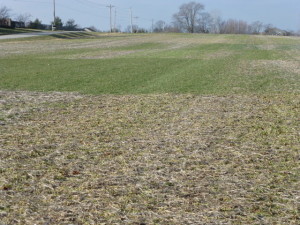
More Fall Cover Crop Field Days Coming
This fall there are more cover crop field days to attend in Iowa and Wisconsin.
For those in Iowa see http://practicalfarmers.org/
In Wisconsin there are two field days:
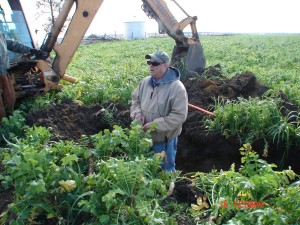
October 21, 2013 – 10:30am – Cover Crop Plot Tour
Hosted by Legacy Seeds’ Kris Tessar and Ag Ventures Shawano
Located at the farm of Paul McClone on Cty BE in Bonduel, WI
Dave Robison will be speaking – Lunch will follow the tour
RSVP to Ag Ventures at 715-524-8812
October 22, 2013 – 10:30am – Cover Crop Plot Tour
Hosted by Legacy Seeds’ Kris Tessar and ADM
Located at the farm of Ken Huber at 3848 Cty P in Oxford, WI
Dave Robison will be speaking – Lunch will follow the tour
RSVP to ADM (Perry or Sue) at 800-367-4057
I hope to see you there! Dave
Badger Plot Cover Crop Research Site – Producer Day Schedule Announced
Join me with Wisconsin NRCS at the Badger Plot Cover Crop Research Site on October 2, 2013 @ Jeff and Jerry Kreuziger Farms near Clyman, WI. Sessions will run from 9:30-Noon or 1:00-3:30 CST. This looks to be a great day to learn more about cover crops and soil health in southern Wisconsin/northern Illinois regions.
For more information see Badger Plot Research-Producer Day.
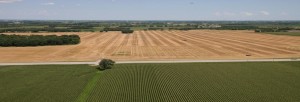
Fall Cover Crop Management
While in southern Minnesota in early September 2013 I was asked when a farmer should plow his cover crop field this fall because he needs the fields to be “black” this winter in preparation for next spring. I shuddered. There I was in a beautiful field of cover crops that are jump-starting some biology on a “biologically dead” field and the farmer wants to kill his biology driving mechanism. UG! The main reason he wanted to till the field was to have warmer soils in the spring where he had black soil. I shared that our research sowed much different results. His thought process sound right but has proven to be a myth, not a fact.
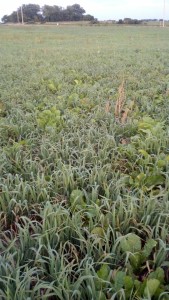
I told the farmer to leave the cover crops in all winter and use conservation tillage next spring. (He’s not a no-tiller.) We dug some shallow root pits for a field day and we found many problems that I believe can be somewhat rectified if the cover crops are left in all winter.
We found many soil health problems in this prevent plant field
- Severe compaction– many areas had compaction starting at 2-3″ deep. Part of that was from spring tillage of wet soils…but the compaction was about 8″ thick as the soil was coming up in blocks the size of cinder blocks!
- Lack of soil biology – I know this because we found a significant amount of corn fodder 2 foot deep that was not even breaking down. It would have been buried with the deep ripper 18 months ago. I could not believe my eyes!
- Lack of aeration in the soil – the soil was literally rock hard. We did find a few earthworm channels but it was so dry that worms were small and deep.
- Low organic matter – I’m not sure how low it was but there was very little soil structure. I talked with a regional NRCS employee and the local SWCD specialist and both men lamented that many of the soils in that region were “about as bad as this one”.
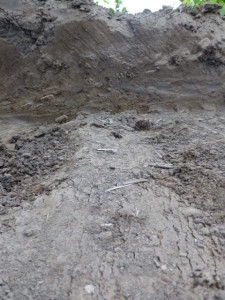
I need to be fair. The farmer currently renting this field has only farmed it a few years and he is making major strides to improve this farm. But he has lots to accomplish before he has a healthy field. Having cover crops are a great first step and he knows it.
Other solutions (instead of cover crops) being proposed to fix the “tight” soils (“unhealthy” soils) in the region
- Tile – LOTS and LOTS of tile has been installed in prevent plant acres this year. Farmers know they need aeration and percolation in their “tight” soils. The regional specialist from NRCS lamented that many farmers don’t believe that cover crops are a solution to make their soils better long term. Tile is not bad; but tile and cover crops are a much better solution.
- Deep ripping – this will get air into the soil and break up compaction, but will it build soil health? No, it will not (note the corn fodder found 2 foot deep in a root pit). Let cover crops naturally deep rip the soil.
- Tillage- and lots of it – many fields in the area had been tilled (disked, field cultivated, etc…) four times already to control weeds…Unfortunately it also reduces organic matter and soil structure and soil health.
So what should happen with the cover crops heading into winter?
- Leave the cover crop growing into the winter – This will give the best opportunity to help with aeration and percolation. This also helps build soil structure and reduce compaction. (See deep ripping, and tiling above…just let the cover crops do this naturally!)
- Sarah Carlson from Practical Farmers of Iowa recently wrote an article about this topic and you can find it here Prevent Plant, Cover Crops, Now What 2013.
- Let the cover crops keep putting down deep roots – we found roots of crimson clover, radishes, cereal rye, annual ryegrass, oats, and Pasja all around 24″ deep. Let them keep growing deeper to open up the soil to get air and moisture deeply into the soil profile.
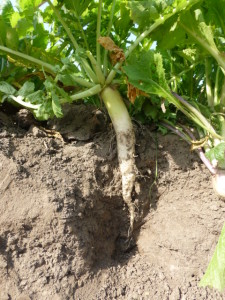
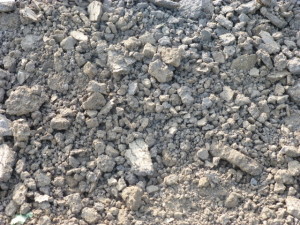
Cover Crop Field Day Set in Blooming Prairie, MN
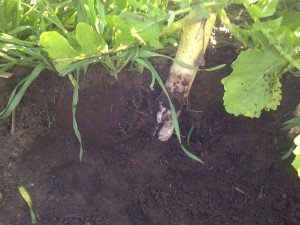
Cover Crops will be the main topic of discussion on September 4, 2013 at a cover crop field day and meeting in Blooming Prairie, MN. I have the privilege of speaking at this event as we look at cover crops on prevented plant acres. We will also look at what cover crops work best in the upper Midwest. We will be on Brad Hagan’s family farm and possibly look at Dale Ramsey’s farm too. Please note that we will be looking in root pits (where the action really is)!
I received this note from Legacy Seeds representative Andrew Heath about the field day/meeting:
“We plan on structuring the event much like an open house with designated times where you will be able to address the crowd. We will start the event at 10 am and have you speak from 11 to 11:45 and again at 1 to 1:45. There will also be transportation to the cover crop plot and some of the field that you, TJ, Brad and I visited earlier with root pits dug. This will happen from 12 to 1 and 2 to 3.”
I have seen the plots and have added photos here on this post to entice you to come if you are in the region.
As a side note, Hagan farms will be no-tilling corn into these fields in 2014. We’ll follow-up on these fields next spring and see how these fields compare to others that did not have a cover on them.
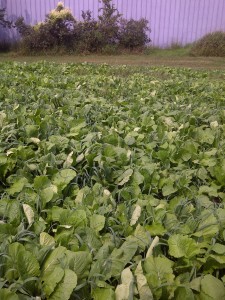
Cover Crops to the Rescue!
A Huge Problem
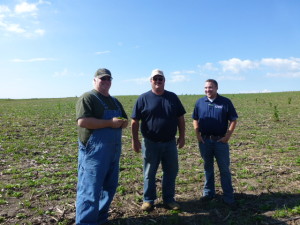
Recently I was in Minnesota with Brad Hagen, T.J. Kartes, and Andrew Heath looking at Brad’s 1,000+ acres or cover crops. Brad had not intended on planting any of theses acres to cover crops in July, 2013…his intentions were to plant them in August or early September. But spring 2013 rains and floods kept Brad from planting corn or soybeans on most of his 1,700 acres near Ellendale, MN (about an hour SW of Rochester, MN ). Brad attended a cover crop meeting TJ set up for me to speak at on behalf of Legacy Seeds last March and as I spoke I could see Brad’s mind working. When the spring rains came so did phone calls from Brad to TJ and from TJ to Andrew or me (or both)…”what can I do to build soil during this disaster?” was the theme of the weekly (if not daily) phone conversations.
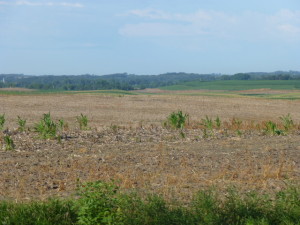
Cover Crops to the Rescue!
Brad’s goals are to build soil and to scavenge nitrogen from his hog operation and build nitrogen with legumes. Realizing that we would plant in early-mid July and not in mid-late August we all understood that we did not want to have to mow to remove seed heads if at all possible – so we left Radishes out of the mix. We also realized that we wanted to use a “summer” clover, so we used Berseem Clover for it’s excellent growth and N producing ability. We chose Oats as the grass in most fields and then we added a twist, Pasja or Vivant Hybrid Brassica. I have worked with Pasja for over 10 years and rarely ever saw it produce a seed head in the summer or fall. While Pasja (nor Vivant) have a big tuber like a Radish they do have the ability to scavenge a tremendous amount of nitrogen and earthworms dwell around their roots.
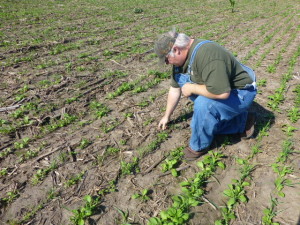
In some later July (and soon to be mid-August) planted fields we chose to use Spring Barley and Crimson Clover along with PileDriver Radishes and Appin Turnips. TJ and Brad requested this mix so we’d get later fall growth, deeper penetration through compacted soils (Radish vs. Pasja/Vivant) and excellent N production from the Crimson clover. Spring Barley was available and many folks in Kentucky have told me that barley makes the soil “sweet” (whatever that means). From experience I know that soil after Barley is quite mellow.
Early August Report
From what I saw on August 1 I was very impressed! As other folks in the region were planting straight Oats or possibly a few were adding Radishes very few other folks seemed to totally share Brad’s goals. Brad told me that he is doing these cover crops because he wants to build his soil and because he wants his 7 year old son to have better soil to farm when he grows up and farms his place like Brad does with his father. I’ll have more photos in a month or so. I believe Andrew, Brad and TJ will plan a field day for September. It’s beautiful country near the Hagen farm…it probably will be worth the drive in September to meet Brad and his family. They’re pretty special folks…
Take a look at my You Tube channel “covercropdave” to watch an interview I have with Brad and TJ.
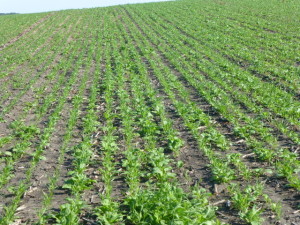
Prevented Planting Seeding Options
I recorded this video a few weeks ago for the seed company I work for. After receiving numerous calls and e-mails asking for help on what to plant, I decided to put this presentation together. Many of the options I mentioned as being viable to plant in mid-June can still be planted in July.
Please check with your seed supplier for availability of the different species. Until new crop is harvested there are several species that are in short supply.
Prevented Planting Seeding Options video.
It may take a few minutes to download the video.
Cover Crops and Prevented Plant Information Guidance
In late June I was on a farm in west central Wisconsin with two farmers that had over 3,000 of their nearly 6,000 acres that were too wet to plant in 2013. This is an example of what I have seen and heard and read on personal farm calls, numerous phone calls, and multiple e-mails that farmers have asked for advice on “what to do.”
On my way home from that on-farm visit I called Ryan Stockwell from the National Wildlife Federation. NWF has been a great friend to agriculture and cover cropping. I wanted to see what Ryan was hearing about potential changes in RMA Crop Insurance rulings for the upper Midwest – so farmers might be able to harvest their cover crops (or alternative forages) from their prevented planting acres before November 1, 2013. What I heard from Ryan was not good news for the livestock producer that is desperately short of feed because of the drought of 2012 and severe alfalfa winterkill during the winter of 2012-13.
As I lamented to Ryan how I thought that there should be some “flexibility” in the crop insurance regulations, it hit me that farmers could possibly make more money harvesting forages and NOT taking their crop insurance payment. That is when we got Sarah Carlson (Practical Farmers of Iowa) and Tom Kaspar (USDA-ARS National Laboratory for Agriculture and the Environment in Ames, Iowa) involved.
If you are considering what to do with prevented planting acres and you need forage, or you are considering whether to put a cover crop on your prevented planting acres, then this article is for you. Please read Cover crops and prevented plant information guidance.
My marking numbers on a notebook I began while driving down I-90/94 tuned into a full fledged article that was well beyond my expectations. Thanks to Ryan, Sarah, and Tom for making this a scientific article that more than solidified my idea and well exceeded my abilities. You guys are the best!
Cover Crops and Prevented Planting Guidelines
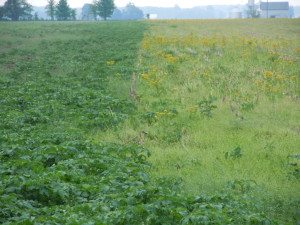
Over the past few weeks I have heard from countless farmers in Wisconsin, Minnesota, Illinois, Missouri, Michigan, and Iowa that are considering taking prevented planting on all or parts of their farms. Growers Edge just published an excellent piece Prevented Planting Guidelines.
Also see my articles on Prevented Planting Row Crop Acres – Which Cover Crops Can Help? and Summer Annual Grasses for Cover Crops for Prevented Planting Acres that may also be helpful.